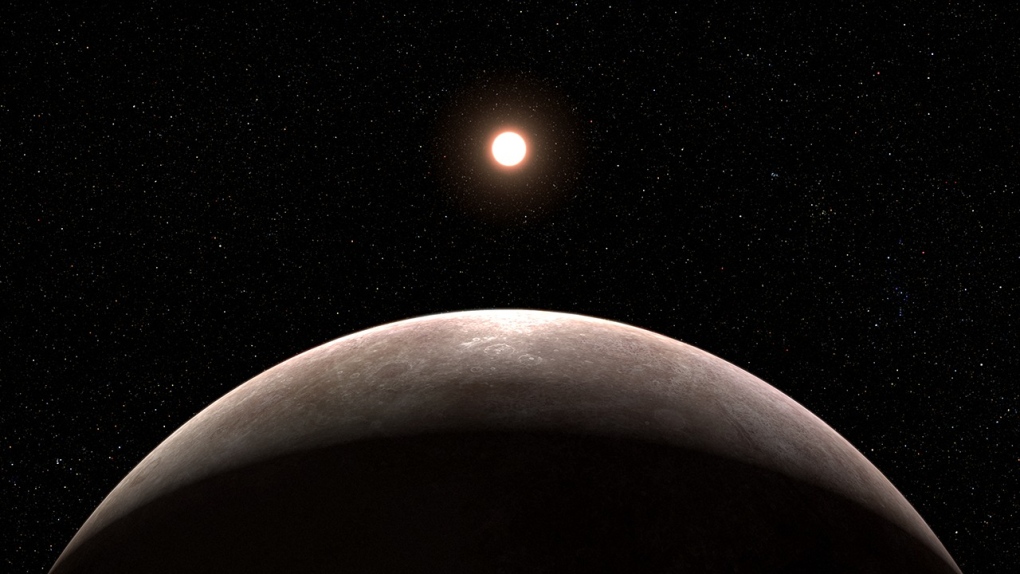How long would it take to travel to the nearest planet to us that could support human life — and, more importantly, how many books and movies would you need to bring with you?
These are some of the questions being explored by the Exoplanet Travel Calculator, an online tool scientists have put together to help us envision what interplanetary travel would actually look like.
“It’s two years since James Webb telescope launched and it’s found lots of exoplanets … we thought ‘OK, we can observe them, wouldn’t it be great if we could go there?’ So how much time would that take to get there?” Steven Wooding, a physicist and one of the creators of the calculator, told CTVNews.ca in a phone interview.
“So, we can calculate how long it would take you to get there. But there’s also other practical things to consider, like food and water. And also we got to thinking, ‘what are you going to do on that trip?’ So we thought ‘oh, how much entertainment would you need’?”
The calculator was built using data from the James Webb Telescope and it’s hosted by Omni Calculator, a site which creates calculators for a whole host of problems, from the cost of fuel per car trip, to the fabric needed to make a circle skirt, to an estimate of how many alien civilizations could exist. Wooding works predominantly on physics calculators “ranging from helpful to educational to raising awareness of different topics.”
To use the exoplanet travel calculator, you simply input your age at the start of the trip and choose one of seven pre-programmed destinations, which will determine how many light years you will need to travel.
The calculator will then tell you not only how long you’ll be zooming through space, but how much time will have passed back home on Earth while you’re travelling. It will also help you figure out what to pack.
Exoplanets, which are planets that lie outside of our own solar system, have long been a source of mystery and study for scientists. But before we could set foot on one, we would have to survive the trip there.
THE PHYSICAL PROBLEMS OF SPACE TRAVEL
To reach LHS 475 b, an exoplanet 41 light years away, it’ll take around seven years and four months to travel there, according to the calculator.
But that’s only the start of the complications. You would need a spaceship that was “quite big,” Wooding said, if you were planning on setting out with all the food you would need for the journey already on board.
LHS 475 b is the nearest exoplanet to us, but you’d still need to bring 6,650 kilograms of food, enough to fill a six-metre shipping container. And that’s not even counting the 603,607 litres of water.
Scientists on the International Space Station already recycle 98 per cent of their water. This strategy would mean you’d only need 12,297 litres for the trip.
By the time space travel is possible, we also might be able to grow our own food on the trip, which would cut down on the space needed.
The food and water needed is based on average consumption data, which includes both drinking water and water needed for washing. Wooding acknowledged that these estimates are probably a little higher than what would actually be used on a spaceship, as we’re more wasteful on Earth than we would be on a meticulously planned out space expedition.
Seven years is a long time to hang out by yourself in a space ship. To stave off boredom, you’ll need 357 books, 2,044 movies and 218 TV show seasons, the calculator estimates.
“I don’t tend to watch movies twice,” Wooding said when asked what entertainment would keep him occupied. “I do like Apollo 13.”
This illustration shows what exoplanet WASP-39 b could look like, based on current understanding of the planet. This illustration is based on indirect transit observations from Webb as well as other space and ground-based telescopes. Webb has not captured a direct image of this planet. NASA, ESA, CSA, Joseph Olmsted (STScI)
TRAVELLING FASTER THAN THE SPEED OF LIGHT — FAST ENOUGH FOR TIME TRAVEL
Eagle-eyed users might be confused at the relative shortness of the calculator’s trips. How would it be only seven years to travel a distance of 41 light years?
This is because there’s an element of science fiction at play here — beyond just the fact that we’re imagining space travel we aren’t capable of yet — when it comes to the speed of these hypothetical trips.
The calculator is operating under the assumption that the advanced spaceship our intrepid explorer is on is capable of accelerating at 1G, Wooding said. G-force is a measure of acceleration, and 1G is equal to the level of acceleration that gravity exerts on us, which keeps us sticking to our planet instead of drifting away into the sky and out into space.
“It’s as though you’re falling towards the planet,” Wooding explained.
1G of acceleration would mean a spaceship was travelling somewhere around a billion kilometres an hour, he added.
If a spaceship were capable of accelerating at 1G, it would produce artificial gravity within the ship. However, the faster we travel, the more our mass increases, upping the physical strain on a hypothetical spaceship. So whether one could travel at this speed constantly is unknown right now.
“We thought this calculator would be good to just show or demonstrate how far these objects really are away from us,” he said.
“So, if you put it in terms of how much food you need to get there, that’s sort of an interesting way to measure rather than just light years, which probably people don’t quite get. They think it’s a time and it’s not, it’s a distance. Then if you put it in miles or kilometers, it’s this stupendously big number and people glaze over.”
Assuming an exceptionally fast ship allows us to more easily imagine the distance, says Wooding. It also helps us look at one of the most interesting parts of potential space travel: the difference between a traveller’s flight time and the time that would pass on Earth.
“Your flight time to the nearest (exoplanet) is seven years. But because the spaceship is going so fast, your time slows down while you’re going that fast. So the time passing back on Earth, on that example, was 43 years,” Wooding said. “So we also included how many generations of your family will be born back on Earth in the time it’s taking you to travel.”
In that example, two additional generations of your family would have been born on Earth by the time you reached your destination.
If you were travelling to WASP-39b, a hot Jupiter-like exoplanet 700 light years away from Earth, an additional 35 generations of your family would have been born back on Earth by the time you completed your 12-year journey, the calculator estimates.
“So if you did manage to get back (to Earth), then the world would be totally different,” Wooding said. “You’ll be effectively travelling into the future.”
ONLY SEVEN YEARS TO THE NEAREST EXOPLANET: INSIDE THE DESTINATIONS
You can manually adjust the calculator to any light year distance to measure other trips, but it comes with seven potential destinations, including five exoplanets, the centre of the Milky Way and the nearest neighbouring galaxy.
“The first one (LHS 475 b) is quite nice because that was the first exoplanet that James Webb confirmed,” Wooding said.
Astronomers had suspected LHS 475 b existed for years, but its existence was first confirmed by the James Webb Telescope a year ago, the first confirmation of an exoplanet for the powerful telescope.
Some of the other exoplanets you can plan your trip to include “a super Jupiter with a strong methane signature … (and) a mini Neptune,” where carbon dioxide and methane have been detected.
One of the highlights is Kepler-186 f, the most Earth-like exoplanet on the list. Discovered in 2014, it orbits its star in what is called the habitable zone, meaning that liquid water – one of the building blocks of life – might be able to form on its surface.
“So that’s a good candidate for visiting,” Wooding said. “Gas giants might be interesting to look at, but we can’t land on them. We could try and land on the Earth-sized rocky planet.”
We still don’t know what space travel between exoplanets would actually look like when — or if — we achieve it. The interplanetary astronauts of the future might be solo travellers with armies of robots to keep them company, or they could be members of large communities crammed into colony ships.
“The next 100 years is going to be exploring our solar system,” Wooding said, adding that we will need to come up with a propulsion system for future spaceships.
“Sending anything like everything to support human life is going to be at least 200 years,” Wooding said.
The calculator might not help us plan any imminent trips to other planets, but it’s a reminder of some of the realities that we’ll have to tackle if we ever do want to travel through space.
“It’s quite fun just to think about these sort of extreme problems,” Wooding said, adding that when we dig into these questions, we start coming up with new questions for research.
“It’s sort of a starting point, maybe, to explore other areas of science,” he said. “There’s quite a lot that comes into it, both physics, space travel and yes, surviving as a human on your own for so long.”




